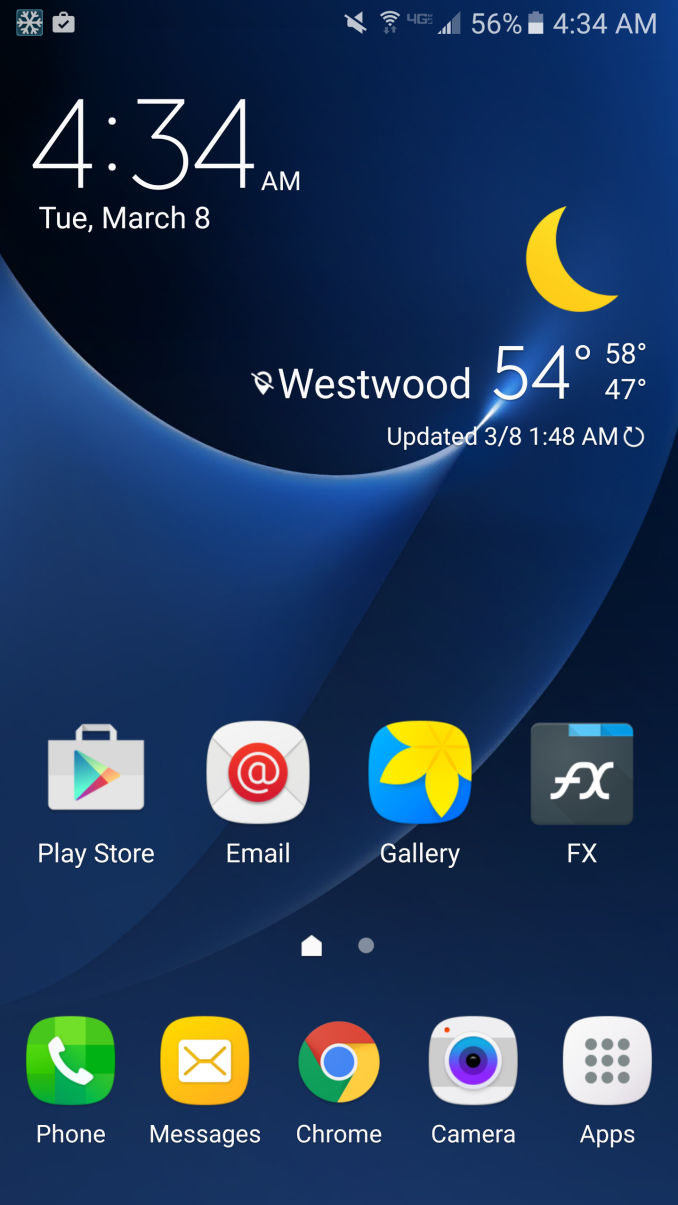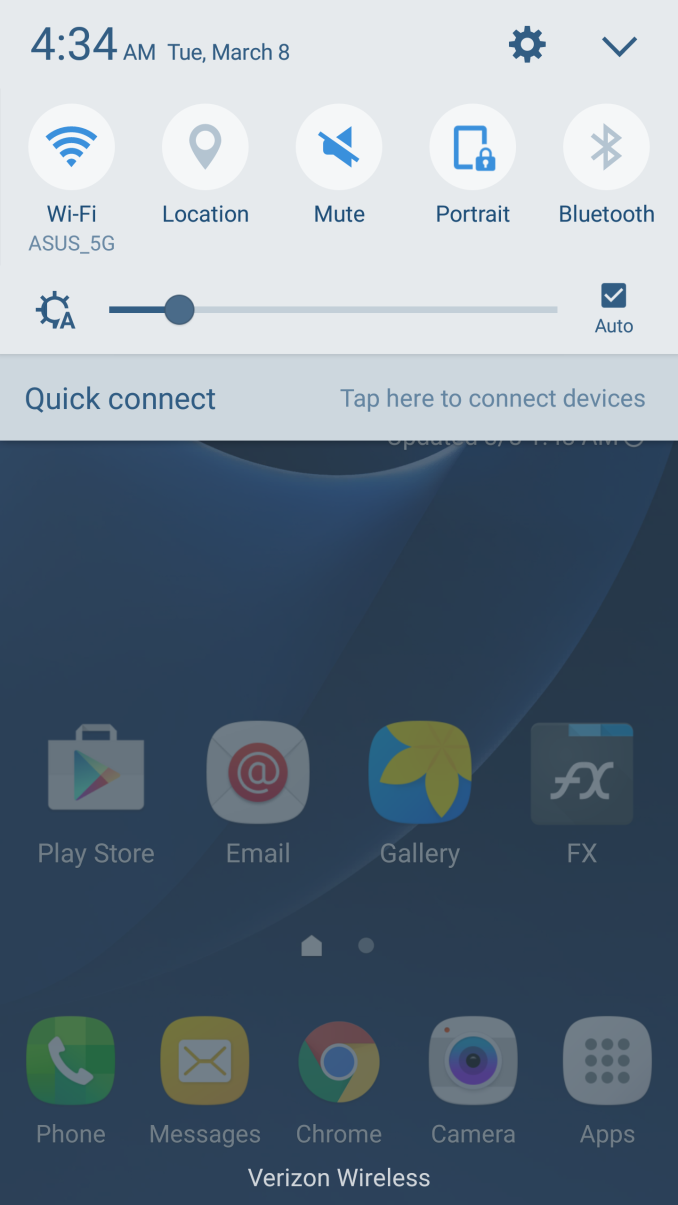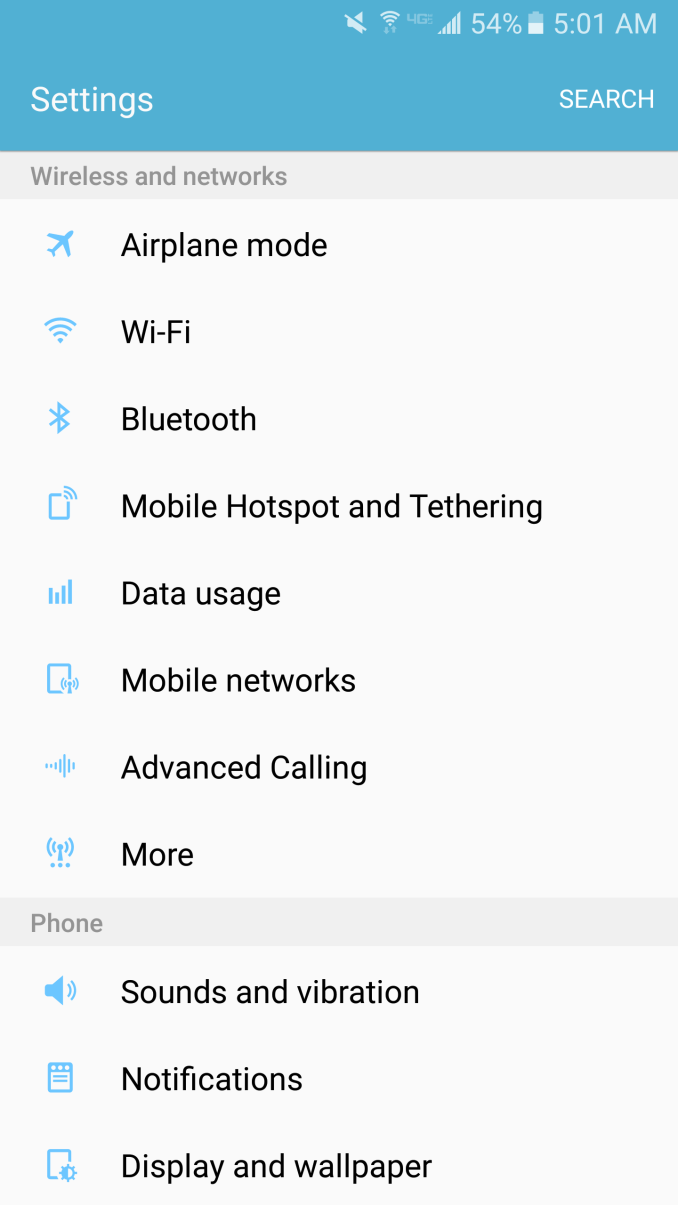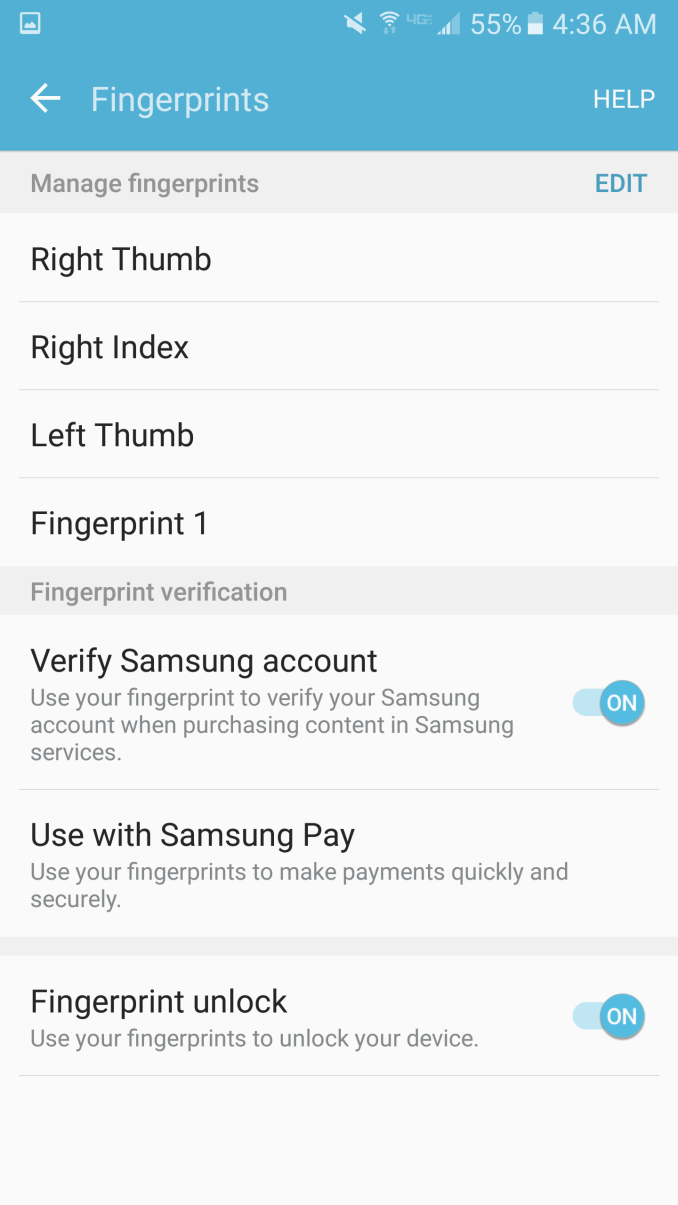The Samsung Galaxy S7 & S7 Edge Review, Part 1
by Joshua Ho on March 8, 2016 9:00 AM ESTSoftware UX
As is always the case, there’s a perpetual debate over the role of the OEM when it comes to Android devices. For better or worse, Samsung seems to believe that they need to add their own framework and UI over Android. To some extent, I suspect that most users are going to find stock Android to be rather spartan out of the box, so it does make sense for OEMs like Samsung to continue adding their own custom applications and frameworks to help differentiate themselves from the competition.
With the Galaxy S5, it was evident that Samsung had dramatically changed their design direction for TouchWiz, but I would argue that their design aesthetic still wasn’t quite perfect, and performance wasn’t completely there either. With the Galaxy S6, Samsung had gotten closer to the mark in some ways, but the continued use of excessively neon colors just made parts of the UI feel off at times, and performance still wasn’t perfect.
With the Galaxy S7, performance has improved noticeably, but it’s really hard for me to say whether this is because Samsung has improved their codebase, or if a faster SoC is just making it harder to notice areas in need of optimization. At any rate, while the Galaxy S7 isn’t perfectly smooth - dropping frames now and then - it is sufficiently performant that you’re not going to find distracting lag.
The default theme of the Galaxy S7 continues to feel pretty similar to the Galaxy S6, so for the most part things are acceptable here, but the use of color is still a bit excessive as a number of icons still use neon colors rather than more neutral pastel colors. Of course, the theme store now has a number of Material Design themes, which greatly improve the situation. I installed one pretty much immediately, which helps make the device feel a lot better in everyday use. However, I’m still of the opinion that this is something that a user shouldn’t need to do out of the box, so this is an area where Samsung can improve.
The other features that Samsung touted for the Galaxy S7 are interesting, but I’m not really sure they’re all that well executed. Always-On Display is nice to have, but for some reason it's quite reluctant to turn off the display when the ambient light sensor and proximity sensor are covered. As a result I turned it off as it’s clearly going to be contributing to idle battery drain in situations where it shouldn’t.
I also found that the fingerprint scanner is pretty much identical to the one in the Galaxy S6, which isn’t entirely surprising as both identify themselves as a Synaptics fingerprint scanner. Both still seem to be quite sensitive to the initial training period and in my experience won’t really work all that well if you don’t cover your entire fingerprint effectively during that period.
Other than this, TouchWiz doesn’t really stand out in any way as of now. Of course, Samsung Pay will be interesting for me to try as I still regularly run into terminals that don’t support NFC in any shape or form, but I haven’t really been able to spend much time testing Samsung Pay yet. I don’t really find TouchWiz to be a bad thing at this point, but I’m not really sure it’s a good thing either. With a serious emphasis on optimization and a major aesthetic overhaul, it’s entirely possible that I could find myself saying quite differently in the near future, but for now if you found the Galaxy S6 and Note 5 OEM UIs to be usable you’ll find the Galaxy S7 to be usable as well.















202 Comments
View All Comments
sachouba - Tuesday, March 8, 2016 - link
Thanks for this review, it's quite good.But I don't understand why the brightness would have been lowered whereas other websites tell the contrary - and Samsung usually increases the maximum brightness on every flagship device.
Moreover, the web battery life test is not representative of actual battery life, because AMOLED displays are very disadvantaged in this test on white web pages, whereas the battery life would be much higher on websites with a lot of dark areas (photos, dark background, etc.).
Some browsers allow you to use a "night mode" which inverts the colors of websites background if the APL is high.
I hope you will review the Exynos version as well - I guess it will be much smoother and with a better battery life, as always.
JoshHo - Wednesday, March 9, 2016 - link
Our new web test has some pages with dark themes currently. However, the overwhelming majority of webpages and UI have a high average picture level. In order to reflect this the vast majority of our webpages are black text on a white background.We are hoping to get an Exynos unit to compare with the Snapdragon 820.
lilmoe - Wednesday, March 9, 2016 - link
Please use the stock browser with Ad block enabled for that test on the Exynos variant. Thanks.deskjob - Tuesday, March 8, 2016 - link
I am totally for prioritizing energy efficiency and battery life over a 100% fluid UI. But I also find it hard to believe that at this stage in the smartphone evolution, a flagship device still can't achieve that goal without adverse effect on battery life. I feel like in the S7's case, it's more likely than not that Samsung and their proprietary UI is at fault for the janky UI performance. Would love it if you guys have time to investigate this further! After all, I am not sure I am not alone in saying a smooth UI is a big part of the everyday smartphone experience.heartinpiece - Tuesday, March 8, 2016 - link
Wow Finally!Will you be reviewing the Exynos 8990 as well?
Seems like a comparison between the 820 and the 8990 would be interesting!
10basetom - Tuesday, March 8, 2016 - link
I can't wait for a detailed comparison between the Snapdragon 820 and Exynos 8890 once you have both S7 models in hand.SydneyBlue120d - Wednesday, March 9, 2016 - link
Same old question, maybe in part 2 of the review we can get an answer: Is unlimited HEVC encoding at 2160p60 with both HDR and IOS supported? Thanks a lot.Osamede - Wednesday, March 9, 2016 - link
While its always interesting to see proper deep dive reviews, I find that these days there is nothing that would get me to buy another Samsung "flagship". Totally overpriced by strategically riding the slipstream of Apple's own boundless greed - except these ones do not hold value at all.s.yu - Friday, March 11, 2016 - link
You must be blind, choosing the recent iCrap over this. Apple's last good looking phone was the 5th generation.pjcamp - Wednesday, March 9, 2016 - link
You say people will find the stock Android interface "rather spartan." That strikes me as odd since I went from TouchWiz to an essentially stock Android on a Moto X Pure. I would never go back. Settings are located where they should be, not moved around at random. Customization is much easier. And stability is no longer an issue. I had, for instance, one major audiobook app that reliably crashed the system under TouchWiz to the point of needing a battery removal to get it restarted. I came to understand that TouchWiz, not the app, was the point of failure during the brief time I used Cyanogenmod and it worked fine. Also works fine on my Motorola.TouchWiz and other skins are not about operability. They are exercises in branding, equivalent to logos. Rather than being nonspartan, they are actually an impediment to usability. If you go to Google to find out how to do something, the instructions will be different from how your skinned phone operates. Sometimes it is easy to translate, sometimes not.
For a lot of people, that probably doesn't matter. But for a lot of people, introducing a skin introduces another potential point of failure, and another opportunity for vendors to point at each other in a circle should there ever be a problem.